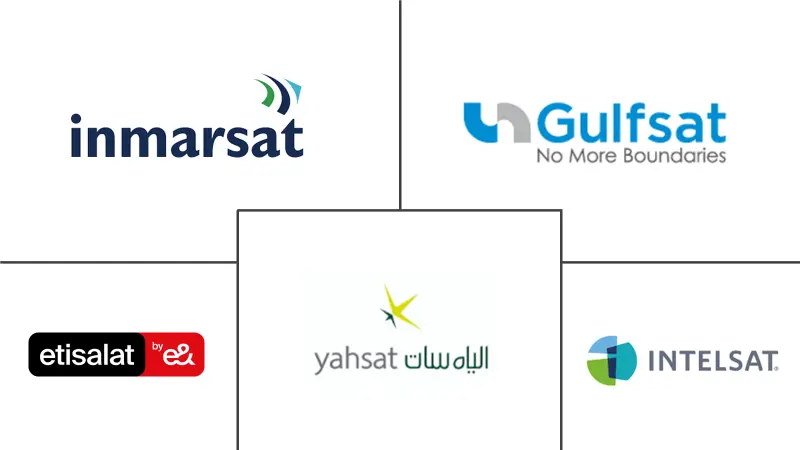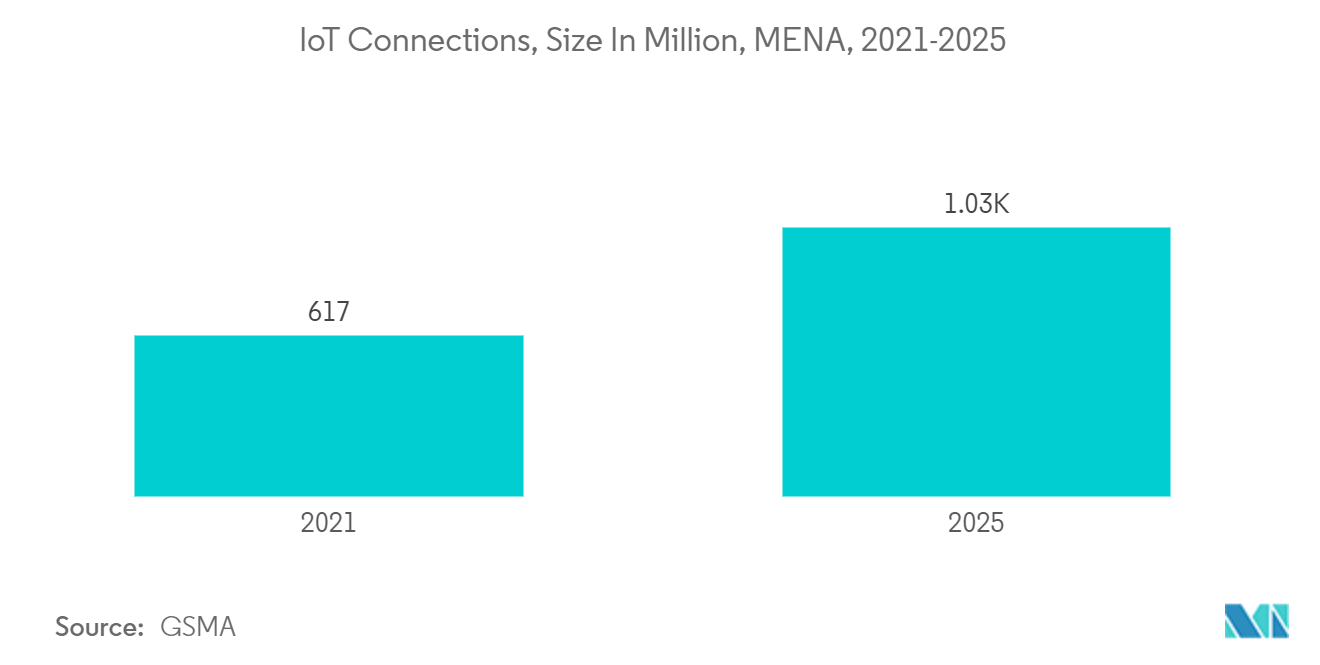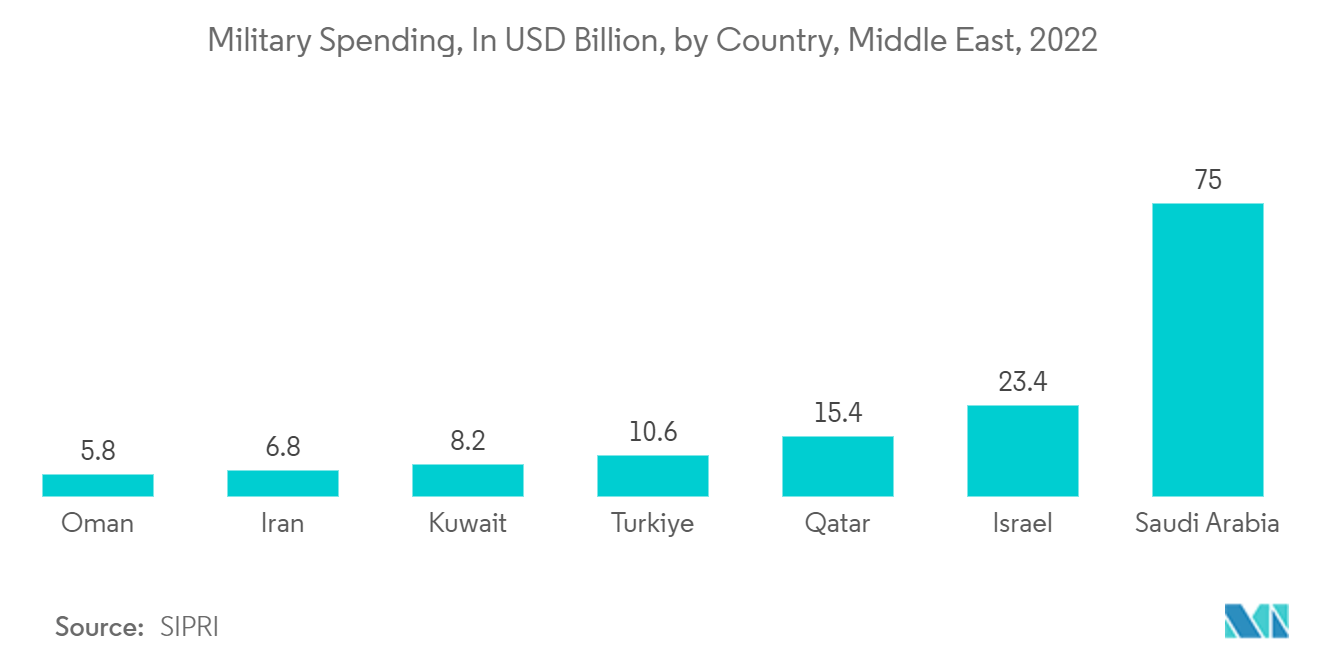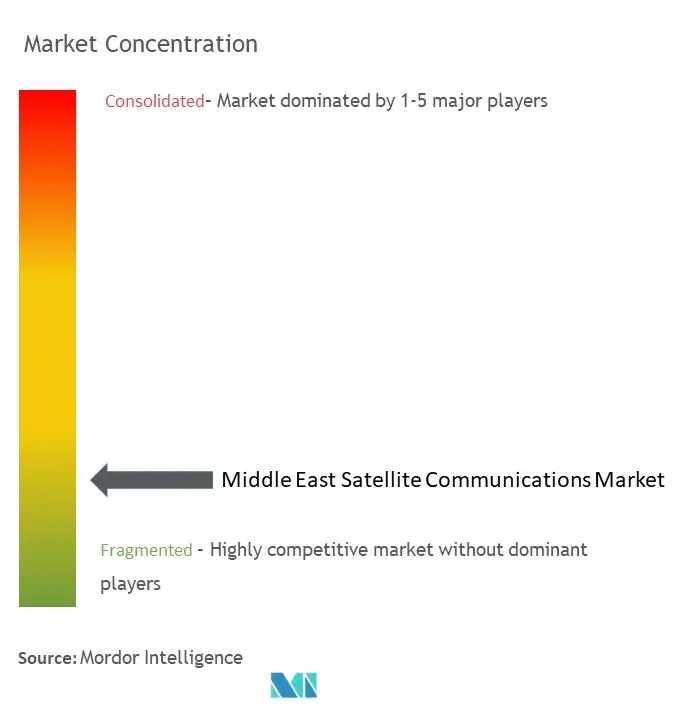Middle East Satellite Communications Market Size

| Study Period | 2019-2029 |
| Base Year For Estimation | 2023 |
| Market Size (2024) | USD 3.35 Billion |
| Market Size (2029) | USD 4.79 Billion |
| CAGR (2024 - 2029) | 7.40 % |
| Market Concentration | Medium |
Major Players
*Disclaimer: Major Players sorted in no particular order |
Middle East Satellite Communications Market Analysis
The Middle East Satellite Communications Market size is estimated at USD 3.35 billion in 2024, and is expected to reach USD 4.79 billion by 2029, growing at a CAGR of 7.40% during the forecast period (2024-2029).
- Factors such as the rising demand for mobile broadband, the growing use of smartphones and smart wearable devices, and the surging demand for mobile video adoption are expected to drive the growth of 5G over the forecast period, which is expected to aid the growth of the market studied. Furthermore, advancements in miniaturization, connected technologies, robust network environment, low-power computing, radio frequency identification, and M2M communication are anticipated to drive the satellite communication market.
- The demand for broadband communications continues unabated and is not necessarily location-specific. Such demands include connectivity requirements for users on aircraft, ships, and vehicles (including first responders) that operate at fixed locations and while in motion. These three platforms need continuous connectivity along their travel routes, often taking them through unserved parts of major metropolitan areas and less densely populated areas. Such trends are expected to aid in the growth of the studied market.
- Changes in satellite communications and the progress in all kinds of telecommunications and computer processes led to the evolution of new opportunities in innovative areas in the sector. As industrial production facilities and mining operations move further into inaccessible terrains, the requirement for efficient wireless interconnection through terrestrial and satellite communications is increasing rapidly.
- To fulfill the operations, the solutions leveraging terrestrial mobile communication infrastructures, typically like long-term evolution (LTE), are relatively slow, expensive, and not easily scalable. Satellite communication is an efficient alternative because of its superior reliability, cost-effectiveness, excellent accessibility, and scalability, thereby providing plenty of opportunities for the growth of the market being studied.
- However, as the region continues to witness rapid advancements in satellite technology and an upsurge in satellite communication services, there is an increased risk and frequency of cyberattacks, which might impact the growth and stability of the satellite communications sector in the Middle East.
- The COVID-19 pandemic increased the demand for satellite communication due to its vast applications in providing voice data. Furthermore, the demand was driven by the increasing need for satellite communications, including internet and broadband services, to continue operations and keep people connected. The entertainment industry has further depended on satellite communication to deliver news and entertainment, which allowed people to remain updated regarding COVID-19 guidelines and other necessary information while being restricted at home. Such increased dependency has largely supported the growth of the studied market.
Middle East Satellite Communications Market Trends
Network Operation Center (NOC) is to Witness the Growth
- A network operations center (NOC) is one or more sites from which network monitoring and control, or network management, over a computer, telecommunications, or satellite network is exercised. Large volumes of voice and video data and intelligence, surveillance, and reconnaissance data are processed in satellite network environments. With enhanced infrastructure, many organizations benefit from better administration and on-demand reporting. With their monitoring capabilities, NOCs help reduce undesirable alerts and alert fatigue.
- As new technologies, like 5G, the Internet of Things (IoT), and edge computing are adopted in the Middle East, deepening complexity defines the future of NOCs. As businesses advance toward cloud-based services and adopt the latest, most innovative technologies, network management must be just as agile, keep pace, and maintain best practices. The NOC is expected to become even more flexible and versatile, to work at its full potential and deliver results, and seamlessly modernize to reflect new, progressive capabilities.
- Further, the growing expansions through collaborations in the region are analyzed to contribute to the market growth rate during the forecast period. For instance, in September 2023, First Tech Web Company Limited, a joint venture between OneWeb, a satellite service provider, and TONOMUS, the tech company powering the ecosystem of cognitive technologies at NEOM – has appointed Albabtain LeBlanc, a Saudi Arabian construction company, to develop a satellite station in Tabuk, Saudi Arabia.
- By providing a consistent, fast broadband connection to people and businesses that are unserved or under-resourced throughout the Middle East regions, this station forms part of joint ventures’ ground infrastructure, which seeks to support the objective of addressing the Digital Divide between Saudi Arabia and the wider MENA region. With Albabtain LeBlanc joining the OneWeb roster for partners across the Middle East, Europe, Africa, and Asia, this station is scheduled to be completed by the end of 2023.
- Overall, the growth of the Network Operation Center (NOC) in the Middle East satellite communications market is primarily driven by several key factors that contribute to the increasing demand for efficient and reliable communication solutions across the region.

Land Segment to Witness the Growth
- The land platform segment refers to satellite communication solutions and services specifically designed for terrestrial operations and communication requirements on land. Land platform solutions in satellite communications are developed to facilitate seamless connectivity, reliable data transmission, and efficient communication services for fixed terrestrial locations, remote sites, and terrestrial infrastructure, thereby enabling users to establish robust and dependable communication links, access critical data, and ensure continuous operational connectivity across diverse terrestrial landscapes and geographical terrains in the Middle East.
- The ongoing development of terrestrial infrastructure in the Middle East, including expanding urban areas, industrial zones, and transportation networks, necessitates robust and reliable communication solutions to support the growing need for data transmission, connectivity, and operational coordination across various terrestrial facilities and locations.
- Additionally, the defense and government sector's emphasis on secure and resilient communication services to support national defense and border security further drives the adoption of satellite communication solutions within the land platform segment. The total military spending in the Middle East was estimated to be USD 184 billion in 2022, up 3.2% from 2021, according to data from the Stockholm International Peace Research Institute (SIPRI).
- The increase was attributed to the Kingdom of Saudi Arabia's 16% spending growth, which resulted in an estimated USD 75 billion in 2022, ranking first in the Middle East and five globally, its first increase since 2018, and Qatar, which ranked third in the Middle East and 20 globally with an estimated spend of USD 15.6 billion, registered the highest year-over-year spending growth of any country, with a 27% increase. The surge in military spending across the Middle East highlights the region's growing emphasis on strengthening national security and defense preparedness, leading to an increased demand for sophisticated satellite communication solutions tailored to the requirements of military and defense applications.
- Overall, the land platform segment in the market is being driven by the continuous development of terrestrial infrastructure, increasing emphasis on secure and resilient communication services within the defense and government sectors, contributing to the sustained growth of the land platform segment in the market.

Middle East Satellite Communications Industry Overview
In the Middle East satellite communications market, numerous vendors vie for prominence through diverse growth strategies such as collaborations, partnerships, and new launches. Notable players include E& ETISALAT (Emirates Telecommunication Group Company PJSC), L3Harris Technologies Inc., Gulfsat Communications Company, Al Yah Satellite Communications Company PJSC, and Inmarsat Global Limited (Viasat Inc.).
In September 2023, Al Yah Satellite Communications made waves with its Government Solutions arm, Yahsat Government Solutions, forging a partnership with the UAE government. This alliance aims to deliver satellite communication-based managed services for the next 17 years, propelling the company's revenue by USD 5.1 Billion and significantly bolstering its market presence across Middle Eastern countries throughout the forecast period.
Simultaneously, Eutelsat Communications SA finalized an all-share merger with OneWeb, a prominent global low Earth orbit (LEO) satellite communications network. Operating commercially as Eutelsat OneWeb, this subsidiary maintains its operational hub in London, marking a significant milestone in the company's trajectory.
Middle East Satellite Communications Market Leaders
-
Inmarsat Global Limited (Viasat Inc.)
-
Al Yah Satellite Communications Company PJSC
-
Gulfsat Communications Company
-
L3Harris Technologies Inc.
-
E& ETISALAT and (Emirates Telecommunication Group Company PJSC)
*Disclaimer: Major Players sorted in no particular order

Middle East Satellite Communications Market News
- September 2023 - Es'hailSat, a Qatar-based satellite company, innovated by launching a Playout Service tailored for television broadcasters. This service aims to support the advancement of the media landscape in Qatar and the Middle East, optimizing broadcasters' operations to ensure an uninterrupted and engaging viewer experience.
- February 2023 - A cooperative agreement was signed between DETASAD and Arabsat. Aligned with the Kingdom's Vision 2030 goals, this agreement aims to expand satellite communications services by investing in research and development, offering collaborative advanced technical solutions. These efforts cater to the needs of various sectors across more than 22 countries. The agreement with DETASAD aligns with Arabsat's strategic goals, focusing on providing satellite communications services to both the public and private sectors to meet their connectivity needs, considering the rapidly expanding Saudi and Arabic markets.
Middle East Satellite CommunicationsMarket Report - Table of Contents
1. INTRODUCTION
- 1.1 Study Assumptions and Market Definition
- 1.2 Scope of the Study
2. RESEARCH METHODOLOGY
3. EXECUTIVE SUMMARY
4. MARKET INSIGHTS
- 4.1 Market Overview
-
4.2 Industry Attractiveness - Porter's Five Forces Analysis
- 4.2.1 Bargaining Power of Suppliers
- 4.2.2 Bargaining Power of Buyers
- 4.2.3 Threat of New Entrants
- 4.2.4 Threat of Substitutes
- 4.2.5 Intensity of Competitive Rivalry
- 4.3 Industry Value Chain Analysis
- 4.4 Assessment of the Impact of COVID-19 on the Market
5. MARKET DYNAMICS
-
5.1 Market Drivers
- 5.1.1 The Growth of Internet of Things (IoT) and Autonomous Systems
- 5.1.2 Increasing Demand for Military and Defense Satellite Communication Solutions
-
5.2 Market Restraints
- 5.2.1 Cybersecurity Threats to Satellite Communication
- 5.2.2 Interference in Transmission of Data
6. MARKET SEGMENTATION
-
6.1 By Type
- 6.1.1 Ground Equipment
- 6.1.1.1 Satellite Gateway
- 6.1.1.2 Very Small Aperture Terminal (VSAT) Equipment
- 6.1.1.3 Network Operation Center (NOC)
- 6.1.1.4 Satellite News Gathering (SNG) Equipment
- 6.1.2 Services
- 6.1.2.1 Mobile Satellite Services (MSS)
- 6.1.2.2 Earth Observation Services
-
6.2 By Platform
- 6.2.1 Portable
- 6.2.2 Land
- 6.2.3 Maritime
- 6.2.4 Airborne
-
6.3 By End-User Vertical
- 6.3.1 Maritime
- 6.3.2 Defense and Government
- 6.3.3 Enterprises
- 6.3.4 Media and Entertainment
- 6.3.5 Other End-User Verticals
7. COMPETITIVE LANDSCAPE
-
7.1 Company Profiles
- 7.1.1 Inmarsat Global Limited (Viasat Inc.)
- 7.1.2 Al Yah Satellite Communications Company PJSC
- 7.1.3 Gulfsat Communications Company
- 7.1.4 L3Harris Technologies Inc.
- 7.1.5 E& ETISALAT and (Emirates Telecommunication Group Company PJSC)
- 7.1.6 Eutelsat Communications S.A.
- 7.1.7 Intelsat S.A.
- 7.1.8 Thales Group
- 7.1.9 Saudi Telecom Company (STC)
- 7.1.10 Raytheon Technologies Corporation
- 7.1.11 Arabsat
- *List Not Exhaustive
8. INVESTMENT ANALYSIS
9. MARKET OPPORTUNITIES AND FUTURE TRENDS
** Subject To AvailablityMiddle East Satellite Communications Industry Segmentation
Satellite communication is the transfer of data and information via satellites orbiting the Earth. It enables long-distance communication by relaying signals between ground stations and satellite receivers in orbit, enabling television broadcasts, internet access, and phone calls.
The Middle East satellite communications market is segmented by type (ground equipment (satellite gateway, very small aperture terminal (VSAT) equipment, network operation center (NOC), and satellite news gathering (SNG) equipment) and services (mobile satellite services (MSS) and earth observation services)), platform (portable, land, maritime, and airborne), and end-user vertical (maritime, defense & government, enterprise, media & entertainment, and other end-user verticals).
The market sizes and forecasts are provided in terms of value (USD) for all the above segments.
| By Type | Ground Equipment | Satellite Gateway |
| Very Small Aperture Terminal (VSAT) Equipment | ||
| Network Operation Center (NOC) | ||
| Satellite News Gathering (SNG) Equipment | ||
| By Type | Services | Mobile Satellite Services (MSS) |
| Earth Observation Services | ||
| By Platform | Portable | |
| Land | ||
| Maritime | ||
| Airborne | ||
| By End-User Vertical | Maritime | |
| Defense and Government | ||
| Enterprises | ||
| Media and Entertainment | ||
| Other End-User Verticals |
Middle East Satellite CommunicationsMarket Research FAQs
How big is the Middle East Satellite Communications Market?
The Middle East Satellite Communications Market size is expected to reach USD 3.35 billion in 2024 and grow at a CAGR of 7.40% to reach USD 4.79 billion by 2029.
What is the current Middle East Satellite Communications Market size?
In 2024, the Middle East Satellite Communications Market size is expected to reach USD 3.35 billion.
Who are the key players in Middle East Satellite Communications Market?
Inmarsat Global Limited (Viasat Inc.), Al Yah Satellite Communications Company PJSC, Gulfsat Communications Company, L3Harris Technologies Inc. and E& ETISALAT and (Emirates Telecommunication Group Company PJSC) are the major companies operating in the Middle East Satellite Communications Market.
Middle East Satellite CommunicationsIndustry Report
Statistics for the 2024 Middle East Satellite Communications market share, size and revenue growth rate, created by Mordor Intelligence™ Industry Reports. Middle East Satellite Communications analysis includes a market forecast outlook to for 2024 to 2029 and historical overview. Get a sample of this industry analysis as a free report PDF download.



